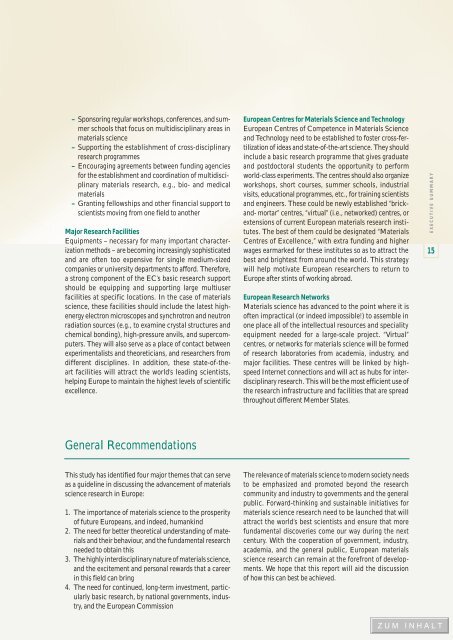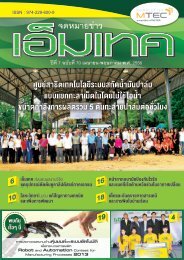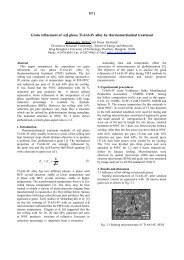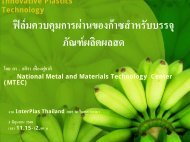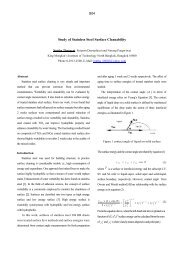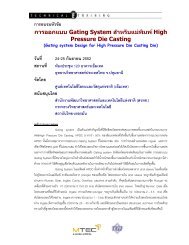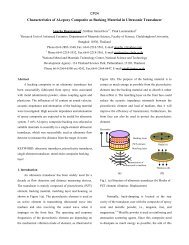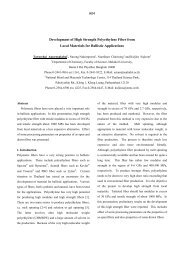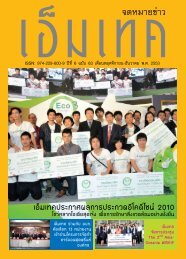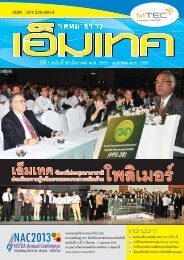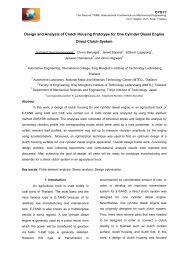EUROPEAN WHITE BOOK
EUROPEAN WHITE BOOK
EUROPEAN WHITE BOOK
You also want an ePaper? Increase the reach of your titles
YUMPU automatically turns print PDFs into web optimized ePapers that Google loves.
– Sponsoring regular workshops, conferences, and summerschools that focus on multidisciplinary areas inmaterials science– Supporting the establishment of cross-disciplinaryresearch programmes– Encouraging agreements between funding agenciesfor the establishment and coordination of multidisciplinarymaterials research, e.g., bio- and medicalmaterials– Granting fellowships and other financial support toscientists moving from one field to anotherMajor Research FacilitiesEquipments – necessary for many important characterizationmethods – are becoming increasingly sophisticatedand are often too expensive for single medium-sizedcompanies or university departments to afford. Therefore,a strong component of the EC’s basic research supportshould be equipping and supporting large multiuserfacilities at specific locations. In the case of materialsscience, these facilities should include the latest highenergyelectron microscopes and synchrotron and neutronradiation sources (e.g., to examine crystal structures andchemical bonding), high-pressure anvils, and supercomputers.They will also serve as a place of contact betweenexperimentalists and theoreticians, and researchers fromdifferent disciplines. In addition, these state-of-theartfacilities will attract the world’s leading scientists,helping Europe to maintain the highest levels of scientificexcellence.European Centres for Materials Science and TechnologyEuropean Centres of Competence in Materials Scienceand Technology need to be established to foster cross-fertilizationof ideas and state-of-the-art science. They shouldinclude a basic research programme that gives graduateand postdoctoral students the opportunity to performworld-class experiments. The centres should also organizeworkshops, short courses, summer schools, industrialvisits, educational programmes, etc., for training scientistsand engineers. These could be newly established “brickand-mortar” centres, “virtual” (i.e., networked) centres, orextensions of current European materials research institutes.The best of them could be designated “MaterialsCentres of Excellence,” with extra funding and higherwages earmarked for these institutes so as to attract thebest and brightest from around the world. This strategywill help motivate European researchers to return toEurope after stints of working abroad.European Research NetworksMaterials science has advanced to the point where it isoften impractical (or indeed impossible!) to assemble inone place all of the intellectual resources and specialityequipment needed for a large-scale project. “Virtual”centres, or networks for materials science will be formedof research laboratories from academia, industry, andmajor facilities. These centres will be linked by highspeedInternet connections and will act as hubs for interdisciplinaryresearch. This will be the most efficient use ofthe research infrastructure and facilities that are spreadthroughout different Member States.EXECUTIVE SUMMARY15General RecommendationsThis study has identified four major themes that can serveas a guideline in discussing the advancement of materialsscience research in Europe:1. The importance of materials science to the prosperityof future Europeans, and indeed, humankind2. The need for better theoretical understanding of materialsand their behaviour, and the fundamental researchneeded to obtain this3. The highly interdisciplinary nature of materials science,and the excitement and personal rewards that a careerin this field can bring4. The need for continued, long-term investment, particularlybasic research, by national governments, industry,and the European CommissionThe relevance of materials science to modern society needsto be emphasized and promoted beyond the researchcommunity and industry to governments and the generalpublic. Forward-thinking and sustainable initiatives formaterials science research need to be launched that willattract the world’s best scientists and ensure that morefundamental discoveries come our way during the nextcentury. With the cooperation of government, industry,academia, and the general public, European materialsscience research can remain at the forefront of developments.We hope that this report will aid the discussionof how this can best be achieved.


